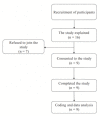Experiences and Psychological Influences in Lay Rescuers Performing Bystander Cardiopulmonary Resuscitation: A Qualitative Study
- PMID: 33489737
- PMCID: PMC7814209
- DOI: 10.6705/j.jacme.202012_10(4).0002
Experiences and Psychological Influences in Lay Rescuers Performing Bystander Cardiopulmonary Resuscitation: A Qualitative Study
Abstract
Background: Bystander-initiated cardiopulmonary resuscitation (CPR) and the use of automated external defibrillation (AED) is pivotal in the community chain of survival, but little is known regarding the bystander experience of performing CPR and AED, and their psychological infl uence from the incidents in the Asian community. This qualitative study was conducted to explore the experiences of lay rescuers who had performed CPR and AED in public locations in Taiwan.
Methods: Lay rescuers who had provided initial CPR and defi brillation with AED in public locations across Taiwan in 2015 were selectively recruited from Taiwan Public AED Registry for a semi-structured interview.
Results: Nine participants were included in the study, and event-to-interview duration was within 1 year (n = 4) and 1-2 years (n = 5). The major fi ndings from the study were: (1) the lay rescuers possessed helping traits and high motivation; (2) the lay rescuers reported certain aspects of rescue reality that differed much from prior training and expectations, including diffi culty in the depth of chest compression, and uncertainties in real emergency situations; (3) the lay rescuers gained positive personal fulfi llment in sharing their experience and receiving positive feedback from others, and were willing to help next time, although they experienced a short-term negative psychological impact from the event.
Conclusions: This study provides valuable information on strategies to increase layperson CPR rates and effectiveness in CPR training. Measures should be taken to increase layperson's confi dence and situation awareness, reduce training-reality discrepancy, build up a support system to avoid negative psychological effects, and prepare lay rescuers for the next resuscitation.
Keywords: altruistic motivation; bystander-initiated CPR; layperson; psychological effect; training-reality discrepancy.
Copyright © 2020 by Taiwan Society of Emergency Medicine & Ainosco Press. All Rights Reserved.
Conflict of interest statement
None.
Figures
Similar articles
-
The Real Experience of Lay Responders Performing Cardiopulmonary Resuscitation: A Synthesis of Qualitative Evidence.Public Health Rev. 2024 Jun 5;45:1606650. doi: 10.3389/phrs.2024.1606650. eCollection 2024. Public Health Rev. 2024. PMID: 38903868 Free PMC article. Review.
-
Reactions and coping strategies in lay rescuers who have provided CPR to out-of-hospital cardiac arrest victims: a qualitative study.BMJ Open. 2016 May 25;6(5):e010671. doi: 10.1136/bmjopen-2015-010671. BMJ Open. 2016. PMID: 27225648 Free PMC article.
-
Psychological impact on dispatched local lay rescuers performing bystander cardiopulmonary resuscitation.Resuscitation. 2015 Jul;92:115-21. doi: 10.1016/j.resuscitation.2015.04.028. Epub 2015 May 6. Resuscitation. 2015. PMID: 25957944
-
Exploring How Lay Rescuers Overcome Barriers to Provide Cardiopulmonary Resuscitation: A Qualitative Study.Prehosp Disaster Med. 2017 Feb;32(1):27-32. doi: 10.1017/S1049023X16001278. Epub 2016 Dec 14. Prehosp Disaster Med. 2017. PMID: 27964771
-
[Lay-rescuer cardiopulmonary resuscitation (CPR)--controversies in emergency medicine: lay-rescuer CPR with or without mouth-to-mouth ventilation].Anasthesiol Intensivmed Notfallmed Schmerzther. 2013 Sep;48(9):558-61. doi: 10.1055/s-0033-1355237. Epub 2013 Sep 18. Anasthesiol Intensivmed Notfallmed Schmerzther. 2013. PMID: 24048666 Review. German.
Cited by
-
The Real Experience of Lay Responders Performing Cardiopulmonary Resuscitation: A Synthesis of Qualitative Evidence.Public Health Rev. 2024 Jun 5;45:1606650. doi: 10.3389/phrs.2024.1606650. eCollection 2024. Public Health Rev. 2024. PMID: 38903868 Free PMC article. Review.
-
What motivates and demotivates emergency response volunteers? A survey-based factor analysis study.Scand J Trauma Resusc Emerg Med. 2023 Aug 12;31(1):38. doi: 10.1186/s13049-023-01101-0. Scand J Trauma Resusc Emerg Med. 2023. PMID: 37568197 Free PMC article.
-
Influence of different relationships of bystanders to out-of-hospital cardiac arrest patients on the effectiveness of dispatcher-assisted CPR.BMC Emerg Med. 2025 Jun 3;25(1):90. doi: 10.1186/s12873-025-01244-6. BMC Emerg Med. 2025. PMID: 40461969 Free PMC article.
-
Follow-up on volunteer responders dispatched for out-of-hospital cardiac arrests: Addressing the psychological and physical impact.Resusc Plus. 2023 Jun 1;14:100402. doi: 10.1016/j.resplu.2023.100402. eCollection 2023 Jun. Resusc Plus. 2023. PMID: 37287956 Free PMC article.
-
Learning Effectiveness Assessment between Primary School Students and Adults in Basic Life Support Education.Emerg Med Int. 2021 Feb 24;2021:5579402. doi: 10.1155/2021/5579402. eCollection 2021. Emerg Med Int. 2021. PMID: 33680515 Free PMC article.
References
-
- Kragholm Kristian, Wissenberg Mads, Mortensen Rikke N., Hansen Steen M., Malta Hansen Carolina, Thorsteinsson Kristinn, Rajan Shahzleen, Lippert Freddy, Folke Fredrik, Gislason Gunnar, Køber Lars, Fonager Kirsten, Jensen Svend E., Gerds Thomas A., Torp-Pedersen Christian, Rasmussen Bodil S. Bystander Efforts and 1-Year Outcomes in Out-of-Hospital Cardiac Arrest New England Journal of Medicine. 2017 May 04;376(18) doi: 10.1056/nejmoa1601891. - DOI - PubMed
-
- Ong Marcus Eng Hock, Shin Sang Do, Tanaka Hideharu, Ma Matthew Huei-Ming, Nishiuchi Tatsuya, Lee Eui Jung, Ko Patrick Chow-In, Edwin Doctor Nausheen, Khruekarnchana Pairoj, Naroo Ghulam Yasin, Wong Kwanhathai Darin, Nakagawa Takashi, Ryoo Hyun Wook, Lin Chih-Hao, Goh E-Shaun, Khunkhlai Nalinas, Alsakaf Omer Ahmed, Hisamuddin Nik A.B. Rahman Nik, Bobrow Bentley J., McNally Bryan, Assam Pryseley Nkouibert, Chan Edwin S. Y. Rationale, Methodology, and Implementation of a Dispatcher-assisted Cardiopulmonary Resuscitation Trial in the Asia-Pacific (Pan-Asian Resuscitation Outcomes Study Phase 2) Prehospital Emergency Care. 2014 Aug 25;19(1) doi: 10.3109/10903127.2014.942482. - DOI - PubMed
-
- Painter Ian, Chavez Devora Eisenberg, Ike Brooke R., Yip Mei Po, Tu Shin Ping, Bradley Steven M., Rea Thomas D., Meischke Hendrika. Changes to DA-CPR instructions: Can we reduce time to first compression and improve quality of bystander CPR? Resuscitation. 2014 Sep;85(9) doi: 10.1016/j.resuscitation.2014.05.015. - DOI - PubMed
-
- Perkins Gavin D., Handley Anthony J., Koster Rudolph W., Castrén Maaret, Smyth Michael A., Olasveengen Theresa, Monsieurs Koenraad G., Raffay Violetta, Gräsner Jan-Thorsten, Wenzel Volker, Ristagno Giuseppe, Soar Jasmeet, Bossaert Leo L., Caballero Antonio, Cassan Pascal, Granja Cristina, Sandroni Claudio, Zideman David A., Nolan Jerry P., Maconochie Ian, Greif Robert. European Resuscitation Council Guidelines for Resuscitation 2015 Resuscitation. 2015 Oct;95 doi: 10.1016/j.resuscitation.2015.07.015. - DOI - PMC - PubMed
LinkOut - more resources
Full Text Sources

